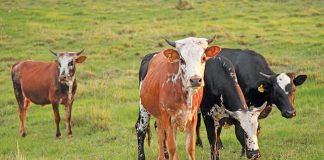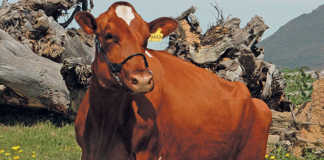
Photo: Danie Bester
Maize farmers who properly understand the growth and development of their plants are better able to apply the correct production and management practices at the right time, and thereby achieve optimal yield.
While producers have no control over environmental stress conditions such as rain or drought, they can mitigate these risks. For example, they can choose a hybrid cultivar, improve their tillage methods, improve the condition of the soil, apply fertiliser, rotate crops, irrigate, and control pests and diseases.
There are two developmental phases in the life cycle of the maize plant: the vegetative phase (V phase) and the reproductive phase (R phase). The former provides the foundation for the latter.
Emergence
Stress at certain critical growth stages of maize during and after emergence can reduce yield dramatically, says Kobus Lindeque, head of Syngenta’s seed business in Africa.
“To start with, a proper seedbed and a good, uniform plant population during the emergence stage is necessary for ensuring the planned yield. It’s important to follow the recommendations of the seed companies regarding the specific hybrid in correlation with the area where the maize is cultivated.”
Lindeque adds that poor or staggered emergence can be problematic. “The longer that seedlings take to emerge, the greater the chances are that soil-borne fungus pathogens can penetrate the plant, leading to damage and yield loss.”
Soil temperature higher than 15°C is required for uniform emergence and vigour. Cool soil inhibits root development and, consequently, moisture and nutrient absorption, slowing development.
During germination, the stem and growth point are 25mm to 40mm below the soil surface. Under warm, moist conditions, seedlings emerge after six to 10 days; under cool or dry conditions, this may take two weeks or more. The optimal temperature range for germination is between 20°C and 30°C, while the optimal moisture content of the soil is about 60% of soil capacity.
After emergence, the plant continues to develop through the various leaf stages, V1 to VT, each representing the number of leaves produced by the plant during that particular stage (see box for explanation).
According to Andries Wessels, seed product development manager at Syngenta, the period from emergence until the V5 stage is critical, and any form of stress placed on the plant throughout this time will have a negative impact on yield.
“From V3 to V5, the number of [kernel] rows per ear that the plant will produce has already been determined. This key yield-determining stage is called the switching point, and for the rest of the season the yield potential can only be maintained or lowered, depending on the growth environment. Yield cannot be increased beyond the switching point stage, and by V8, the number or kernels per row has been laid down.”
From V3 to V5, the growth point is still underground, where it is heavily influenced by soil temperatures. A low soil temperature can extend the time between leaf stages, and although damage caused by hail, wind and frost at this stage has little effect, it can delay the growth period by a few days. In addition, waterlogging while the growth point is still below ground, especially when associated with high temperatures, can result in significant stand loss.
The vegetative phase is followed by the first stage of the reproductive phase (R1), during which the silk is formed. This is also an important stage, as water and nutrient stress can lead to strained development of the maize ears.
Root development
Leonard Oberholzer, market development lead for South Africa at Bayer Crop Science, suggests that a soil auger, a spade and a water-filled spray bottle be kept at hand to carry out quick plant root and soil inspections.
The auger will enable you to identify possible soil compaction, and check the moisture level and depth of the soil. The spade and spray bottle help with root examinations. Oberholzer adds that the roots play a fundamental role in the development of the plant, as they allow for the uptake of water and nutrients.
“Weather, soil properties, fertiliser and pestscan influence the growth and distribution
of the root system in the soil. Root development is also a good indication of what is happening in the soil. Physical and chemical characteristics of soil can influence root development, and if you notice something during this stage of the plant’s development, it will determine further actions.”
Maize plants grow rapidly during the first 30 to 40 days after planting, and you should provide adequate nutrients. This is the time to look for signs of nutrient deficiency. The plants should be deep green in colour; purple-tinged leaves could mean the plants are suffering from a lack of phosphorus, whereas light-green leaves indicate a lack of nitrogen.
Leaf samples can confirm deficiencies and help to determine corrective actions and how much of a certain fertiliser you should apply.
When the plants are between four and six weeks old, you can apply a top dressing with ammonium nitrate/urea. Maize grown in sandy soil may require a split top dressing, with the first half applied at four weeks and the second at seven weeks after emergence.
Weed control
Weeds can significantly reduce maize yield. In previous research, weeds caused yield losses of up to 12,8%, despite weed-control applications; when the weeds were not controlled at all, losses rose to 29,2%.
Wessels says it is important to start the production season with a field free of weeds and competition so that the seedlings can develop unhindered.
“Weed control is an important management practice for maize production that should be carried out to ensure optimal grain yield and support the switching point yield level. Weed control, especially in the first 10 weeks after crop emergence, is essential, as it will reduce the competition from weeds for available light, water and nutrients.”
Make use of an integrated weed management programme, combining cultural, mechanical and chemical methods. Techniques such as higher planting densities and crop rotation can be included in the programme. If mechanical methods are used, be careful not to approach the plants too closely after the V2 stage, as the root system can easily be damaged.
A wide selection of herbicides is available for maize. Choose a weed control programme to manage those weeds that are the most difficult to control.
Acetanilide can be used before and at planting, while atrazine can be used pre-emergence and later in the season. Combining acetanilide at planting with atrazine later on will ensure good control of both grasses and broadleaf weeds.
Oberholzer offers the following word of caution, however: “When rainfall is particularly late, and you decide to replant a land with sunflower, ensure that atrazine has not been applied to the land earlier.”
With glyphosate-tolerant maize, you can apply approved glyphosate and registered products to the land without harming the crop; only the target weeds will be killed.
Leaf stages once again come into play with herbicide applications. If you spray certain herbicides during emergence under cold and wet conditions, the plants may be damaged. Seek expert advice if you are unsure.
Refrain from spraying glyphosate on top of the maize plants from the V8 stage onwards or after the development of the sixth true maize leaf, which generally is about four to five weeks after emergence.
Doing so can damage the growth point and the pollen, compromising pollination and, consequently, yield. Glyphosate can be sprayed using a boom with drop-arms to direct the spray to the lower parts of the plant and the inter-row soil surface.
Managing herbicide resistance
With herbicide-tolerant crops, farmers are often tempted to overuse the single herbicide that the crop is resistant to. Resist this temptation! Make the effort to use products with different modes of actions. According to CropLife South Africa, the frequent use of a similar mode-of-action herbicide is probably the biggest factor in the development of herbicide resistance in weeds.
“Managing resistance is generally much more effective than dealing with a resistant weed when it becomes difficult to control. The best way to proceed is to ensure that a variety of herbicides with different modes of action are used. This can be done in tank mixes where the herbicides are compatible, or in sequential applications where they’re not,” advises Oberholzer.
The following simple programmes can be used. Note, however, that they are dependent on the weeds present, the number of weeds, and the planting density of the maize:
- Glyphosate at or after planting, followed by glyphosate before the sixth-leaf (V8) stage.
- Acetochlor with a safener at planting, followed by two applications of glyphosate before the sixth-leaf (V8) stage. The second glyphosate application could be made after the sixth-leaf (V8) stage if it is directed away from the funnel.
- Glyphosate at or after planting, followed by glyphosate and acetochlor around the sixth-leaf (V8) stage. When applying herbicide, follow the instructions carefully and take the necessary safety precautions.
Email Kobus Lindeque at [email protected], Leonard Oberholzer at [email protected], or Andries Wessels at [email protected].











